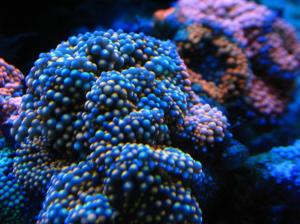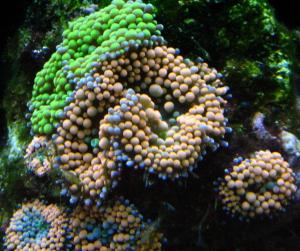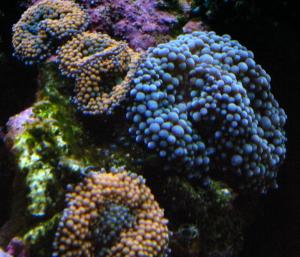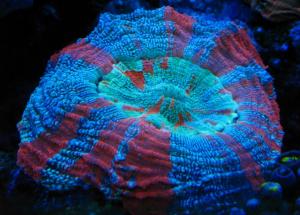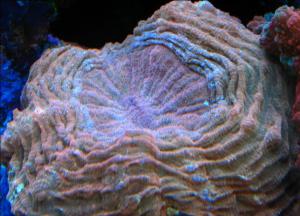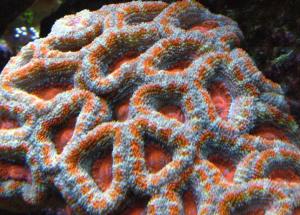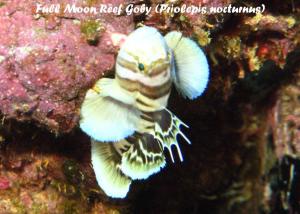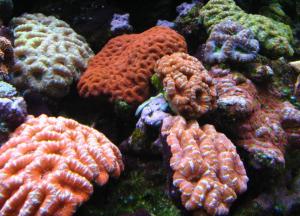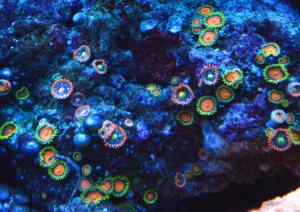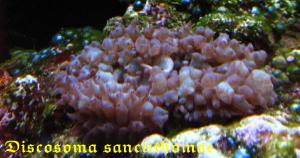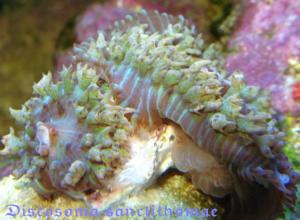-
Posts
4,897 -
Joined
-
Last visited
-
Days Won
7
Content Type
Profiles
Forums
Gallery
Everything posted by kueytoc
-
Ricordea florida ...The Corallimorpharian for Every Aquarist Genus Ricordea There are two species of Ricordea that show up with frequency in the hobby—they are R. yuma and R. florida. The former is an Indo-Pacific species, while the latter—the subject of this article—is indigenous to the tropical Western Atlantic. While both are beautiful animals that adapt well to aquarium life, many aquarists are drawn to the vibrant colors of R. florida and the price, which is frequently less than R. yuma. Taxonomy The genus Ricordea is one of three commonly accepted genera in the Family Corallimorphidae (ITIS), which belongs to the Order Corallimorpharia and the Subclass Hexacorallia. It’s worth drawing attention to this taxonomic structure to point out that Ricordea species are indeed hexacorals, just like anemones (Order Actiniaria), stony corals (Order Scleractinia) and zoanthids (Order Zoanthidea). The internal structure of Ricordea species is remarkably similar to the internal structure of their cousins, the stony corals, while their outward appearance closely resembles their other cousins, the anemones. This is why you may sometimes here Ricordea referred to as both “false corals†and “disc anemones.†The taxonomic classification of Ricordea is also important to the marine aquarist in terms of understanding collection impacts. The collection of Scleractinia is restricted (CITES II) in U.S. waters (including U.S. territorial waters), and while Ricordea is not a member of the Order Scleractinia as explained above, the rocks on which Ricordea grow are indeed classified as Scleractinia. As a result, the hobbyists should never see a wild collected R. florida sold on a rock larger than 2.5 cm in diameter. Natural Habitat In the wild, R. florida is frequently found growing in colonies that blanket rock rubble in shallow, turbid waters. They may also be found in deeper waters and as solitary animals. Growing in both horizontal (perpendicular to the seafloor) and vertical orientations, R. florida attaches itself by way of a pedal disc to just about any hard substrate. The color of an individual specimen may be related to its natural habitat and, specifically, to the depth at which it was collected and the turbidity of the water. Individuals living in shallower water with full exposure (horizontal orientation) are frequently paler in color with shades of yellow and brown being common. Orange (and sometimes even pink) specimens may also be found in shallow water. In the wild, R. florida is known to change colors seasonally or in response to specific events such as hurricanes. Husbandry As with most marine animals kept in the aquarium, a great deal can be inferred about their husbandry based on the natural habitat and understanding the animal’s innate behavior. In the following sections, this article looks specifically at placement, feeding, tankmates, and disease. Placement One of the reasons that Ricordea are appropriate for the beginning aquarist is that they are fairly tolerant of a wide range of lighting and flow conditions. As noted above, these animals are found in varied conditions in their natural habitat, and, so long as they are properly acclimated to the hobbyist’s aquarium, they will do well in a much wider range of aquarium conditions than many anemones and corals. Just as in the wild, aquarium specimens will be attached to hard substrate. This is usually a small piece of rock or coral skeleton on which the animal is shipped. This rock may be placed on the bottom of the aquarium or may be glued or epoxied to the rockwork in either a horizontal or vertical position. In short, R. florida tolerate bright reef lighting much better than most other corallimorpharians, but they also do fine in less well-lit situations such as shaded areas of the aquarium or in tanks without metal halides. Under metal halides, consider a lower, somewhat shaded or vertical placement in the aquarium. Note that such a placement may encourage the extension of the specimen’s column, which can make for a very attractive display. With less intense reef lighting, think about a shallower, horizontal placement. As always, the aquarist should carefully observe a newly placed Ricordea specimen. If the specimen grows paler and shrinks, the lighting may be too intense. If an originally brightly colored specimen retains its size but loses some of its intensity, the lighting could probably be stronger. In terms of aggression, Ricordea florida is a motile semi-aggressive animal. While it should be given room to grow (and should certainly NOT be placed in such a way that it will come into direct contact with other stinging-celled organisms), there is little danger to other motile invertebrates posed by Ricordea. Ricordea florida does best with low to moderate, indirect and intermittent flow. Feeding Ricordea, like all corallimorpharians, are symbiotic insofar as they rely on symbiotic zooxanthellae for food production. Having said this, it’s important to note that Ricordea are often found in shaded locations or growing in vertical orientations in their natural habitat. In fact, it is known from experience that many Ricordea specimens actually do better when not exposed directly to bright reef lighting (e.g. metal halide lights) in the aquarium. The reasons for this are not totally understood, but probably have something to do with the animal being able to rely on a combination of photosynthetic and chemosynthetic food production. In addition to photosynthetic and chemosynthetic food production, Ricordea do rely on filter feeding to a lesser or greater degree depending on the individual specimen and, more specifically, the length of the individual specimen’s tentacles. These animals are not generally well-adapted to prey capture, as can be readily gleaned by looking at the mouth disc. While it is not unusual for Ricordea species to possess multiple mouths (polystomatous), the tentacles around those mouths often more resemble “bumps†than the tentacles of other filter feeding corals. Target feeding phytoplankton and zooplankton (or commercially available foods designed for filter feeding invertebrates) a couple times a week is appropriate, although, as many will state, not absolutely necessary. Tankmates While R. florida may well be damaged or destroyed by non-reef compatible animals, it is one of the few corals that is worth trying with some animals that are considered “reef compatible with caution.†Disease There are few known diseases which plague Ricordea specimens in the aquarium. Most problems are the result of inappropriate lighting or poor water conditions, although a specimen with a damaged pedal disc resulting from poor collection practices is very susceptible to bacterial infection which can cause the animal to virtually disintegrate overnight. Likewise, fragmented specimens that have not fully healed before shipping are especially vulnerable. Supplementing trace elements can help R. florida to adapt to various lighting situations and maintain excellent health. Propagation Captive propagation of Ricordea florida is easily achieved by carefully cutting the individual animal in half straight through the mouth disc, column and pedal disc. Care must be taken to insure that the tools used are clean so as to avoid any bacterial contamination. Propagating Ricordea in this manner is easy for the experienced hobbyists and has a very high success rate with the animals healing fully within several weeks under ideal aquarium conditions. Conclusion For many reasons, R. florida is an ideal aquarium animal for any reef aquarist. Hardy, beautiful and interesting, these “false corals†or “mushroom anemones†add color, variety and beauty to almost any saltwater aquarium.
-
Acanthophyllia Deshayesiana Meat Coral is one of many common names used in describing Acanthophyllia deshayesiana, but this is an apt title, as this species has a thick and fleshy polyp. Their fleshy skin is rather delicate and care must be taken when placing them in the aquarium so the thick, toothy skeleton doesn't cause too much damage to the soft tissue. When the soft tissue expands, it drapes dramatically over the edges of the skeleton. Color may vary from red-brown to bright green or red, and, in some cases, specimens may be striped or mottled with another color. Place these corals either low in the tank or firmly anchored midway up in the tank, with low water movement. They do produce food through photosynthesis, but will also except an occasional meaty foods placed near the mouth opening. Meat Coral is similar to, and often confused with, Scolymia corals. Note: This species was formerly identified as Cynarina deshayesiana but has recently been reclassified by the U.S. Fish Wildlife Service.
-
-
Common Name: Circus goby, Gecko goby, White Tiger goby, Half Moon goby Scientific Name: Priolepis nocturna Size: Less than 2â€, though their fan-like pectoral and caudal fins may make them appear larger. Origin: Indo-Pacific. Fishbase.com lists the following: Aldabra and Assumption Island, Cosmoledo Group, Seychelles; Marquesas, Maldives. Natural Habitat: This cryptic little goby is found in tropical rocky/reef areas, hiding upside down in caves. Feeding Requirements: Typical of most popular gobies in the aquarium trade, the gecko goby quickly accepts all aquarium foods, both frozen and dry. Difficulty Rating: (1 = easy - 5 = hard) 1 = Easy. In the proper reef environment (see below), this fish is hardy and eats with gusto. Aggressiveness Rating: (1 = shy - 5 = nasty) 2 = Not aggressive. In my experience, this fish adopts an “ignore them and they will leave†attitude, whether faced with small inquisitive fish or very large passers by. Captive Requirements: As mentioned earlier, these fish thrive in a standard reef environment. Their hearty appetites lend them to be excellent choices for any marine tank, assuming certain requirements are met. Caves and overhangs are a must. Beyond that, the fewer large, boisterous tank mates, the better. Obviously, tankmates large enough to eat or otherwise thrash this little gem are a no-no. Prior to adding tangs and Genicanthus angels to my aquarium, my little gecko goby would slowly patrol the entire aquarium, with quick stop/start movements. As soon as larger fish were added to the system, the goby would remain hidden under ledges and such. Brief appearances are a treat as he darts out for food. Optional Requirements: I enjoy keeping fish in pairs. I simply added another gecko goby to my established one. They paired without incident. I have even seen one individual with a distended belly containing orange/pink eggs on more than one occasion. There are two other reefers that I know of that have had the same relatively simple experience with pairing their gobies. However, they have not witnessed breeding. It is unclear to me as to whether or not these fish will fight if paired with the same sex. Reef Tank Compatible: Again, because of their laid back nature, the gecko goby is an excellent choice for a reef aquarium. They do have large mouths, so be cautious with VERY small ornamental shrimp such as sexy shrimp (Thor ambeonesis), and the like.
-
-
-
Discosoma sanctithomae - Bubble Mushroom aka Warty Mushroom, Atlantic Bubble Mushroom, Warty Corallimorph, St. Thomas Bubble Mushroom The Bubble Mushroom stands out in the mushroom crowd, with lower water temperature requirements and high, yet indirect lighting ! The Discosoma sanctithomae, most commonly known as the Bubble Mushroom or Warty Mushroom, is named for the shape of its tentacles. It is also known as the Atlantic Bubble Mushroom, Warty Corallimorph, and St. Thomas Bubble Mushroom. It is a well known and favorite mushroom coral, offering a distinctive look to the reef aquarium. This is a larger mushroom, and can grow to 4" (10 cm). One of its unusual characteristics is that it will sometimes close part way, into a "purse-string" style, and quickly capture an unwary fish seeking to hide in the "enclosure". Their tissue is very thin however, and can tear easy. The Bubble Mushroom usually comes in translucent green, blue, yellowish green, purple-mauve, green, brown and orange with tentacles that may contrast in color and be iridescent. Instead of having long feeder tentacles, their tentacles will form rounded vesicles or they may elongate to take on a fuzzy appearance. Like other mushrooms, the tentacles do have toxins in them. This mushroom is very decorative and moderate to easy to care for, but it is a more expensive mushroom coral. The Bubble Mushroom is a good choice for Metal Halide lit tanks, since it likes indirect intense lighting. You may have to experiment on locations for maximum size, color and reproduction. They are a bit more difficult than the Actinodiscus genus because they are not as tolerant of poor water conditions. They also cannot handle a high water flow since it will prevent them from getting nourishment. The D. sanctithomae propagates easily in captivity, which can contribute to preserving the wild populations. After splitting however, the clone mushroom doesn't necessarily always resemble the "mother" mushroom, thus giving the aquarist a variety of shades and colors. They have very few predators if any.
-
Wine and beer lovers can drink to this Channel NewsAsia - Tuesday, February 23 SINGAPORE: Travellers, especially wine and beer lovers, will now have more options when it comes to buying duty—free alcohol. In his Budget statement on Monday, Finance Minister Tharman Shanmugaratnam said travellers will be able to buy an additional litre of duty—free wine or beer in place of one litre of duty—free spirits. This means that those who prefer wine or beer will be able to enjoy a duty—free allowance of two litres of wine and one litre of beer, or two litres of beer and one litre of wine. "This has the makings of a suitably difficult PSLE (Primary School Leaving Examination) Maths question," said Mr Shanmugaratnam, drawing laughter from Members of Parliament. Travellers who frequent duty—free outlets cheered the news. Administrator Jeffrey Yeo said he would now be able to stock up on wine for occasions such as office parties or family gatherings. The 37—year—old wine lover added that "though long overdue, this initiative is definitely welcomed as it brings Singapore in line with international regulations on duty—free alcohol." But hospitality executive Melvin Heng, 24, said the move would not change his buying habits. "Though it is always great for consumers to have more choices, I would rather see an increase in quota for all three categories of beer, wine and spirits," said Mr Heng, who likes buying spirits. TODAY/sc
-
Where got LAW ??? Let due process of law handle Romanian hit—and—run case: Minister Yeo Channel NewsAsia - Tuesday, February 23 SINGAPORE: Foreign Affairs Minister George Yeo has said there are due processes of law in Singapore and Romania to deal with the hit—and—run accident linked to Romanian diplomat Silviu Ionescu. Speaking in Parliament on Monday, Mr Yeo said Singapore must take one step at a time and and not act in haste. He appealed to Singaporeans not to speculate but let the law take its course. The Bukit Panjang accident on December 15 last year claimed the life of a pedestrian, 30—year—old Tong Kok Wai. "Some have criticised the Singapore government for not acting immediately to detain him (Dr Ionescu). I fully understand the outrage many Singaporeans feel over the hit—and—run accident and the tragic death of Mr Tong," said Mr Yeo. "However, we should never do anything that is not in keeping with due legal process, nor descend into trial by media. Otherwise, we will weaken our own case." Mr Yeo also highlighted efforts to get Dr Ionescu, who left Singapore two days after the accident, to attend the coroner’s inquiry next month. "If Dr Ionescu was, as he had claimed, not the driver, then it would clearly be in his own interest to attend or to have a lawyer to represent him at the inquiry to present his version of the events, as well as to question witnesses," said Mr Yeo. Another request was for Romania to waive the diplomatic immunity of another central figure — Dr Ionescu’s driver Marius Trusca — so that he could testify at the inquiry. As both sides communicate on the official level, conflicting reports were flying in the media on the status of the driver’s immunity. Some said his immunity has been waived while others claimed it had not. Singapore’s hope is that the Romanian Embassy will act without undue delay as the inquiry is starting early next month. Mr Yeo stressed that Singapore will not tolerate any abuse of diplomatic immunity and believes the Romanian authorities share this view. CNA/ir
-
HOT OFF THE PRESS Singapore government's FY2009 budget deficit was $2.9b By Lin Jiamei, Channel NewsAsia | Posted: 22 February 2010 1545 hrs SINGAPORE: The Singapore government incurred an overall budget deficit of S$2.9b for financial year 2009. The figure, at 1.1 per cent of Gross Domestic Product (GDP), is lower than the deficit of S$8.7b budgeted a year ago. Delivering the Budget Statement in Parliament on Monday, Finance Minister Tharman Shanmugaratnam said this "better than expected performance" reflects the return of confidence to Singapore's economy. The Singapore economy contracted by 2 per cent last year due to the economic downturn. Resident unemployment reached 5 per cent in the third quarter of 2009 but has since fallen to 3 per cent. Looking ahead, Mr Tharman said the prospects for 2010 are good, though it is important to be watchful for "risks". He added that the path to recovery is unlikely to be smooth. "Prospects for 2010 are good although we have to be watchful for risks. The IMF projects world growth to swing from negative territory in 2009 to 3.9 per cent this year. However the path to recovery is unlikely to be smooth," said Mr Tharman. "The problems over sovereign debt in Greece could be contagious. Efforts by governments to reduce deficits so as to prevent unsustainable increases in debts, while necessary, will inhibit growth over the short term." Barring further major problems, Singapore's economic growth is expected to be around 4.5 to 6.5 per cent this year. Mr Tharman said this is a "strong expansion" though it does not reflect what the Singapore economy can sustain over the medium to long term. There is a need to increase Singapore's productivity by 2 to 3 per cent a year over the next decade, as mapped out by the Economic Strategies Committee. CNA/ir
-

MANCHESTER UNITED...the RED DEVILS march on !!!
kueytoc replied to kueytoc's topic in General Reefkeeping_
Fergie won't panic despite tired United's defeat AFP - Sunday, February 21 LIVERPOOL, England (AFP) - – Sir Alex Ferguson admits Manchester United are showing signs of tiredness as the title race gathers pace but he insists there is no need to panic in the wake of his side's 3-1 defeat at Everton. United have now lost six Premier League matches in the current campaign and have not been defeated as many times in the league since 2004. They have also suffered three other defeats in cup competitions - against Besiktas, Leeds and Manchester City. Yet United manager Ferguson, who saw his side lose an eight-match unbeaten run, maintains he is not worried about his team's defeats in a season of alarming inconsistency. But the Scot did concede his players, who won 3-2 at AC Milan in the Champions League in midweek, showed indications of fatigue on Saturday. "We left something in Milan and certainly there was tiredness in the team but we're going for a championship and we expect Manchester United to respond to the importance of the game," Ferguson said. "They've all been bouncing this week and been great. It's a small possibility we've left something there but certainly we looked very tired. "We were well beaten, simple as that and I'm disappointed. Of course the players are disappointed. They're human beings but they play for Manchester United and they don't like losing." Despite his frustration at yet another defeat, Ferguson has no worries about his players' ability to recover as he looked ahead to the home game against West Ham on Tuesday. He added: "We've been responding for a long time so I don't expect a problem with that. "It's a bad result for us and at this time of the year you can't afford results like that. We hope others drop points and that can happen because of the way the league is going this season. "That's the way it has been and hopefully it turns that way again. I don't think we'll panic." Everton have moved to within seven points of the top four with a run of just one Premier League defeat since November. They have recovered well from a difficult start to the campaign but Moyes admits they have probably left it too late to mount a sustained challenge for a Champions League place. He said: "It's a long way off for us but I would rather see us coming from behind and up on the rails and we'll have to. It can change. "We thought there was a period when we'd pick up points but the Premier league this year is so tight that there isn't a guarantee that you will pick them up wherever you go and whoever you play. "We can start looking upwards a little more than downwards certainly. We've started a tricky month pretty well. We're delighted." American forward Landon Donovan, who is on loan from LA Galaxy, produced another outstanding performance against United. His loan spell runs out next month and Moyes admits that he will be unable to extend the deal. Moyes added: "I dont think you bring many players from abroad who start the Prmeier League up to speed. In some games there's been a dip but he was always a chance. He always looked as if he had something about him. "I think Landon would probably like to stay but at the moment it looks as if not and I wouldn't want to show any disrespect to his club or his contract over there." Dimitar Berbatov gave United an early lead but Diniyar Bilyaletdinov pulled Everton level with a 25-yard drive just two minutes later. And Everton secured their win thanks to late goals from young substitutes Dan Gosling and Jack Rodwell. -
Home buyers still flock to showrooms despite new property measures Channel NewsAsia - Sunday, February 21 SINGAPORE: New measures kicked in on Saturday to curb speculation in the property market. A Seller’s Stamp Duty will be imposed on all residential properties bought on Saturday and sold within one year, while housing loans from financial institutions will be capped at 80 percent of property value. Are they taking the buzz out of the property market? Not yet — at least not for those who are buying for the long—term. It was business as usual at one property showroom on Saturday, as a steady stream of visitors checked out the units available. Sales of units at the Altez condominium — located just opposite Tanjong Pagar MRT station — are moving fast. One woman in her 30s snapped up four units — two to stay in and two to rent out. The condominium’s developer said they could still sell an entire floor of units within an hour. Some home buyers said the reduction in the home loan limit did not make much of a difference. Home buyer Raphael Tan said: "The banks have been very strict, anyway. So I think we will still be on track for our financing." And those who are buying for the long—term are not worried about the new Seller’s Stamp Duty. Doris Chia, another home buyer, said: "Although it’s quite pricey now, I think this is a good location and for long—term investment." Analysts expect developers to launch more high—end properties in the first half of this year. These properties typically sell at S$2,000 per square foot and attract buyers and investors who are less price—sensitive. Donald Han, managing director of Cushman and Wakefield, said: "A lot of the high—end investors are typically not bound by any limitation. They don’t go for maximum loan—to—value ratio. In some cases, they just go for 40 to 50% of loan—to—value ratio. In some cases, they even buy on a cash basis." Analysts said the mood to buy won’t change much as the measures are meant to flush out speculators, who make up a small percentage of the market. CNA/ir
-
Household income for 2009 falls across the board Channel NewsAsia - Saturday, February 20 SINGAPORE : Household income from work fell in real terms across all income groups in Singapore last year. This is according to figures released by the Department of Statistics on ’Key Household Income Trends, 2009’. Findings indicate that Singapore’s bottom 10 per cent was the hardest hit. 2009 was a rough year for all. Each member of the poorest group of households got a monthly income of S$334, down from S$340 in 2008. In real terms, the average income per household member among employed households fell by 3.5 per cent. But things were not rosy for Singapore’s top 10 per cent employed households as well. Their average monthly income from work fell by 2.3 per cent. Associate Professor Tan Khee Giap, Lee Kuan Yew School of Public Policy, said: "Those who got hit hard are not just the blue—collar (workers), but also the white—collar (workers). That is why you are also seeing white—collar (workers) having severe...pay cuts. 2009 was an unusual year, we should see (things) picking up over the next two years." The fall across the various income groups is accounted for by the weak labour market conditions last year, which saw higher unemployment rates and lower wages. This also led to an increase in the number of persons not working in a household. Meanwhile, the median monthly household income from work among all resident households dropped by 1.9 per cent — from S$4,950 in 2008 to 4,850 in 2009. Higher consumer price inflation meant that resident households saw real income fall by 2.5 per cent, a far cry from the growth of 6.1 per cent in 2008. Among resident households, those living in one— and two—room HDB flats saw the greatest fall of 13.9 per cent in median monthly household income. Those living in bigger housing types saw a 2.3 per cent drop in real terms. According to the paper, median household income from work fell 1.8 per cent for those living in four—room HDB flats. But there is a silver lining. Government schemes like the Resilience Package helped narrow the rich—poor income gap. A measurement of income inequality, also known as the Gini coefficient, was 0.453 in 2009, down slightly from 0.454 from the previous year. Associate Professor Tan said: "The income gap as measured by the Gini coefficient since 2007 and 2008 has been narrowing. This is basically due to the government subsidies and rebates, including the Workfare (Income) Supplement Scheme..." Lower income groups benefited the most. On average, the Resilience Package added S$2,460 per household member to resident households in one— and two—room HDB flats. Those in three—room flats got S$1,600. This was more than the S$930 per household member for households in private flats and landed properties. Associate Professor Tan said: "We should look towards this coming Budget on Monday, where the lower income group will be addressed, and where the blue—collar workers, low—wage (workers), would have to be encouraged, by asking them to work longer and make up the difference for the low pay they are getting." This may be possible, given the government’s latest upward revision of the economic growth for this year. CNA/ms
-
Government announces 2 measures to cool property market Channel NewsAsia - Saturday, February 20 SINGAPORE: The Government has introduced two new measures to cool the property market and pre—empt a bubble from forming in the private homes sector. They come into effect Saturday. The Ministry of National Development said this will help ensure a stable and sustainable property market, and to curtail the HDB resale market where prices tend to track private property movements. From Saturday, it will be more difficult and expensive for speculators to own and flip properties. A Seller’s Stamp Duty will be imposed on all residential properties and residential land bought after Friday, and sold within one year from the date of purchase. The housing loan limit will also be capped at 80 per cent — down from the current 90 per cent. This new loan limit will apply to all housing loans granted by financial institutions for private homes, executive condominiums, HUDC flats and HDB flats, including those sold under the Design, Build and Sell Scheme. But loans granted by the Housing and Development Board (HDB) for flats, will still have a cap of 90 per cent. Last September, the Government introduced anti—speculative measures to cool the private homes market. While these helped initially, there were signs the market was heating up again. The new measures come as demand for private homes continues to soar. The number of units sold by developers in January was three times more than December. It was also the highest monthly total since September last year. The Ministry said the objective of these measures is to discourage short—term speculative activity that could distort underlying prices. It is not targeted at the purchase of properties for owner occupation or longer term investment. Market watchers said the measures are easiest to implement, without causing the market to come to a standstill. Eugene Lim, associate director, ERA Asia Pacific said: "We are recovering. The economy is recovering and the market is picking up so what they want to do is to make sure the property market is moving up in tune together with the economy and not faster than the economic recovery." Analysts added that the prices and volume of private property homes are unlikely to be significantly impacted. Donald Han, managing director, Cushman & Wakefield said: "It has got a fairly minimal impact to the market, mainly because a lot of investors from our records are buying for the medium term, at least for a period of two to three years. "Some investors will probably stand by the sidelines and see how sales progress into February and March. It will take some wind out of the market; potentially it could be around 10—15 per cent in terms of the numbers of new home sales taken out of the equation." The Real Estate Developers’ Association of Singapore said the reduced mortgage cap is unlikely to have significant impact on genuine buyers and investors, as lending institutions have already been more prudent in the aftermath of the global financial crisis. CNA/sc
-
Glenn: "I can propose anytime already." Xin.sg - Friday, February 19 Some people say the official length of that 'honeymoon period' in a new relationship for dating couple is between eight and twelve months - that is how long it takes to get the relationship 'itch'. Well, not for Glenn Ong and Jean Danker. Forget about dishing out ugly arguments and catching sights of the slightest signs of complacency from the couple. The ostentatious display of affections coupled with a diabetic dose of lovey dovey-ness by the pair of lovebirds during this interview almost got my partner into deep shit, I kid you not. According to this Class 95FM DJ couple, nobody gives in or out-talks each other; instead arguments are always "talked-over and managed in a way that a relationship is supposed to be managed". "That was what I was unable to do before with my other partners," Jean said. "Even in the way in which he phrases things to me in order not to hurt my feelings." Admittedly, Jean revealed that Glenn mostly has the last say but in a good way. "He's a little more experienced when it comes to handling relationships [and] he obviously has had some lessons to impart and I think I've a lot to learn in that respect." Glenn added: "The most important thing is that you become wiser and a better person from previous failed relationships. I hope I'm managing this relationship well." "Yes you are," came the fast-and-furious loving reply from Jean. One year on, this couple still radiates with such passionate affection you wouldn't think twice about grinding them into pieces if you'd just been dumped. Love was clearly in the air when I met with Glenn and Jean last week - they had just celebrated their first anniversary last month - for a chat on their love journey thus far. "I definitely feel that I love him more than I have at the start. He's been really great and really sweet, I can't ask for more," Jean mused. Glenn said gushingly: "I'm just really glad that everything's been so perfect. She's very kind, sweet, sexy and giving, couldn't ask for more." Their year-old romance, till this day, has remained quite a discussion topic ever since their love story ignited a media storm over a year ago. Love them or hate them, Glenn Ong and Jean Danker are 'soul' connected that Glenn is "ready to propose anytime already". Do we hear wedding bells ringing for the couple? "Well he has to ask!" the affable Jean replied with a gleeful chuckle before she took to a slightly more serious tone: "If we want to, we should really think about it seriously and not do it because everybody wants us to." Cooingly, Jean added: "It's a feeling, it's been right so far and I can say that very certainly. I haven't been this sure about anyone ever." Snuggling up to each other on the couch with the ever doting Glenn gushing over his ladylove and Jean getting all teary-eyed at some point talking about her beau, one can't help but feel the genuine love and respect they have for each other. So, perhaps wedding bells in the later part of 2010 then? "Hmm, we'll see," Jean replied in a near whisper before she burst into laughter. "Yes we'll see but I definitely want to be with this woman. I can't get enough of this girl!" Cosying up to Jean, Glenn added: "There's a good feeling and very positive vibe." To which, Jean turned to look at her beau and said: "Ditto."
-
Where do you DIVE usually ?
-
MM Lee warns of dangers of slow growth if productivity does not increase Channel NewsAsia - Friday, February 19 SINGAPORE: The future is promising for Singaporeans, but challenges such as increasing productivity and raising skills across the board need to be tackled in the next five years, Minister Mentor Lee Kuan Yew said. Mr Lee made the assessment at the Tanjong Pagar GRC’s Lunar New Year dinner. The Minister Mentor also said he expects Singapore’s economy to grow between four and six per cent this year. Speaking to residents in his constituency, Mr Lee said Singapore has done well in the last five years. The island state has a growing economy, increasing real incomes, better homes which are rising in value, and citizens are generally better off. To take advantage of the economic opportunities and make up for low birth rates, Singapore had to increase its immigration. There were also more foreigners working in Singapore on Work Permits, S—passes and Employment Passes. These foreign workers contribute to the country’s economic growth. Mr Lee noted that in the past few months, the government has taken further steps to widen the differentiation between citizens and Permanent Residents, and to slow down the inflow of foreigners. However, he said Singaporeans must recognise that without foreign workers in the construction, manufacturing and service industries, many projects, such as the integrated resorts (IRs), could not have been possible. "These two IRs have increased jobs available, and will bring a huge number of tourists and give a boost to our economy," the Minister Mentor said. "Foreign workers also built housing and infrastructure projects like public transport, schools and hospitals all over Singapore. Without them, these projects could not have proceeded and our economy would slow down, to the detriment of Singaporeans." Mr Lee explained that if Singapore wants to slow down the intake of foreign workers and yet continue to prosper, local workers must increase their productivity. "Let me explain what happens when we make progress. HDB prices go up, private home (prices) go up, all asset prices go up. Everybody finds he owns something more valuable in the house, his shares are worth more and he can live a good life," said Mr Lee. "Of course we have to put up with more crowded trains, more crowded buses, (but) it cannot be helped. "Let me tell you what happens when we slow down too much. You get the reverse spiral. Low growth, maybe even zero growth. Last year we had minus two per cent. Prices go down, property prices go down, incomes go down, you can’t refurbish your houses, no new SERS, no upgrading and the country goes down. "So between the two — growth against no growth, I am confident we chose the right decision — growth, whatever the inconveniences or competition for space, buses, MRTs, and even schools. But we always give preference to our own citizens. "Without growth, Singapore will not be what it is and the key to our growth is a government taking right decisions and labour unions, employers, and the government working together. No other country in the world has got this combination." "The same number of Singaporean workers must produce more by getting better training, acquiring higher level of skills, working smarter and making a collective effort as the Japanese do to make their companies succeed. "If we cannot increase the productivity or the output of our citizens, our economy will slow down. We will have a deflating economy, with a series of knock on effects as prices of all assets, including flats will go down... demand will lessen, pay will fall and so will the number of jobs and promotions." Mr Lee added that when this happens, talented Singaporeans will leave for greener pastures, which will lead to Singapore’s decline. "That is why the government decided in the past five years that it was better to grow the economy and manage the accompanying social pressures rather than slow down the economy. If our neighbours grow and we stagnate, Singapore will face a very different geo—political environment in the future." Hence, to do well in the next five years, Mr Lee said that Singaporeans must raise skills across the board, have more enterprise innovation, and restructure the industries. Every worker also has to be re—skilled, re—trained and re—educated to achieve higher standards of capabilities. Mr Lee said he believes a three—way partnership that involves the government, unions and employers can achieve this. In his Budget speech next Monday, Finance Minister Tharman Shanmugaratnam is expected to elaborate on how Singapore plans to tackle these issues, which have been highlighted by the Economic Strategies Committee. CNA/yb Singapore ups growth view but may stand pat on policy Reuters - 1 hour 13 minutes ago By Saeed Azhar and Fabian Ng * Govt ups 2010 GDP growth forecast to 4.5-6.5 pct vs 3-5 pct * Economy shrank annualised 2.8 pct q/q s/adj in Q4 * Economists expect c.bank to stand pat on policy in Apr * Inflation outlook lowered slightly due to rebasing of CPI SINGAPORE, Feb 19 - Singapore raised its economic growth forecast for this year after reporting better-than-expected fourth-quarter data, citing a pickup in trade and industrial production and stable financial markets. The government now expects gross domestic product to grow by 4.5 percent to 6.5 percent in 2010, up from a forecast of 3 percent to 5 percent made only a month ago, the Ministry of Trade and Industry said on Friday. The economy shrank 2.8 percent in the fourth quarter on a seasonally adjusted, annualised quarter-on-quarter basis, much better than the initial government estimate of a 6.8 percent contraction made last month. Economists said the central bank will likely keep its monetary policy unchanged at its next scheduled review in April, citing officials' concerns about the global economy in the second half of 2010 and benign inflation. "I don't think there is an immediate push for them to do anything with monetary policy, given they are still concerned about the second-half outlook," said Selena Ling, head of treasury research at Oversea-Chinese Banking Corp in Singapore. The Monetary Authority of Singapore sets policy by managing the value of the Singapore dollar <SGD=> against a secret basket of currencies. The current policy calls for a stable currency. "We expect the MAS to maintain its neutral FX policy in April and to tighten only in October," said Standard Chartered Bank economist Alvin Liew. UNCERTAIN OUTLOOK The government said its upgrade from the earlier 3.0 percent to 5.0 percent GDP growth forecast reflected "increased strength in the near-term growth momentum". It brings the official forecast in line with private sector estimates. "The outlook for the second half of the year remains uncertain. Private final demand in the G3 may remain weak, as there are still few indications that non-policy induced private demand is gaining strength," it said. Ravi Menon, a permanent secretary at the Ministry of Trade and Industry, told reporters that he was more concerned about private consumption in the United States than sovereign risks in European countries such as Greece and Spain. Economists expect Singapore Finance Minister Tharman Shanmugaratnam to announce a number of growth-supporting policies in his 2010/11 budget on Monday. "Even as the government steps away from the 'emergency' mode that the 2009 budget was formulated in, they are likely to retain a 'better safe than sorry' stance," noted Robert Prior-Wandesforde at HSBC in Singapore. The government raised its 2010 trade growth outlook to a range of 9 percent to 11 percent from an earlier forecast of 7 percent to 9 percent. It expects non-oil domestic exports to rise by 10 percent to 12 percent this year. It lowered its 2010 inflation forecast to 2 percent to 3 percent from the previous 2.5 percent 3.5 percent due to a rebasing of the consumer price index. For the whole of 2009, Singapore's gross domestic product shrank by 2 percent following a revised 1.4 percent rise in 2008.
-
Tutankhamun not effeminate: Egypt antiquities chief AFP - 2 hours 2 minutes ago CAIRO (AFP) - – The pharaohs were not effeminate despite the appearance of Tutankhamun on his golden bust, Egyptian antiquities chief Zahi Hawass said Wednesday as he unveiled new evidence about the life and times of the famed boy king. The results of an extensive study showed King Tut's father Amenhotep III, the pharaoh and his forebears were unlikely to have had the feminine physiques they are depicted as having in 3,000-year-old artefacts. "People said he was deviant and effeminate... (but) he was a sound man like all of us," Hawass said. The antiquities boss announced the results of the study involving DNA tests and computerised tomography (CT) scans on Tutankhamun's mummy at a packed media conference in the Egyptian Museum. It also revealed that the boy king died of malaria after a fall, used a cane and was the son of the monotheistic pharaoh Akhenaten. Related article: Tut probe shows power of technology -- but raises questions too "We found evidence from DNA that proves he had very severe malaria," Hawass said. "He was ill, weak, walked on a cane. When he was 19, and got malaria, he fell, how we don't know, maybe he fell in the bathroom," he said. "When he fell, and was weak from malaria, he died." Researchers from Egypt used DNA testing to draw a family tree for Tutankhamun, and their results were reviewed by German scientists. The researchers, led by Hawass, analysed DNA taken from 11 mummies, including the boy king himself. They scanned all but one of the mummies to determine if they were related, looked for evidence of genetic disorders and infectious diseases, and determine what killed Tutankhamun at the age of 19. Tutankhamun -- who is often referred to as King Tut -- died just nine years into his reign, which lasted from 1333 to 1324 BC. Hawass said what seemed as an injury to the back of Tutankhamen's skull, which some had taken as evidence that he was murdered, was in fact a hole made by embalmers. The testing also showed he was fathered by Akhenaten, the controversial pharaoh who ruled from around 1351 to 1334 BC and tried to radically transform religion in ancient Egypt. The antiquities chief added that researchers were able to determine that the previously unidentified mummy found in the KV 55 tomb belonged to Akhenaten. His mother was determined to have been an unidentified queen whose mummy, known as the Younger Lady, was once believed to have been Queen Nefertiti. Hawas also ruled out Nefertiti as Tutankhamun's mother. She was found by a French archaeologist in 1898 in tomb KV35, along with the mummies of Amenhotep II and other pharaohs. The testing showed that one of the mummies, known as the Elder Lady, was the powerful Queen Tiye, Tutankhamun's grandmother and wife of Amenhotep III. The results of the study were published in the Journal of the American Medical Association on Wednesday. Tut also sired two children, both girls, but they died in the womb, the study found.
-
FANTASTICO mate !!! How's ya 'Bubbles' doing ???
-
U.S. Considers Endangered Species Protection for 82 Stony Coral Species By CORAL Editors - Posted on 16 February 2010 A move to place more than 80 species of stony corals on the Endangered Species list appears to be gaining traction with the U.S. federal government. A petition from an Arizona-based environmental group calls for protection of 8 Caribbean and Western Atlantic species, 9 corals in the Hawaiian Islands, and 66 species from the Indo-Pacific. The National Marine Fisheries Service (NMFS), the National Oceanic and Atmospheric Administration (NOAA), and the Department of Commerce have opened a 90-day finding period seeking to hear “scientific and commercial information†on whether a long list of stony coral species would be given protection under the Endangered Species Act. The 83 species included in the original petition range from four species of Acanthastrea, 22 species of Acropora, 3 species of Euphyllia, 8 species of Montipora, and 4 species of Turbinaria. Among the corals on the list are such commonly kept aquarium species as Euphyllia parancora, Galaxea astreata, Pavona cactus, Turbinaria reniformis, and many species of Acropora. The move was initiated by the Center for Biological Diversity, headquartered in Tucson, Arizona, a non-profit dedicated to conservation. The Center claims the petition, originally submitted October 20, 2009, was ignored until they threatened to sue the National Marine Fisheries Service. The announcement that the group’s petition had been accepted came February 10. Of the 83 original coral species, 82 were found to have significant enough evidence of compromise to justify further status reviews. The Fisheries Service ruled that there was not enough evidence to consider a listing for the Western Atlantic Ivory Tree Coral, Oculina varicosa, but that the others warranted further consideration. “This is a call to action,†said Marshall Meyers, CEO of the Pet Industry Joint Advisory Council (PIJAC) in Washington. “There may be some species that do need protection, but to list all of these corals demands serious science-based, credible studies demonstrating that each of these species is endangered.†If listed, the corals would be banned from collection in U.S. waters, banned from import into the United States; interstate shipment would become illegal. Captive propagation would require a federal permit, and corals could only be bought and sold within states. “Effectively, this would end the international trade in stony corals to the United States,†Meyers said in an exclusive interview with CORAL Magazine. “I think many people have been taken by surprise and don’t yet know the implications. In addition to the marine aquarium hobby, this could impact anyone who comes near a coral reef in U.S. waters, including boaters, fishermen, divers, and tour operators. Using the Endangered Species Act in this way is part of a crusade, the breadth of which we have never seen before.†Once a species is listed as endangered, sanctions are levied against anyone who “takes†a specimen. “Taking†is defined as “harassing, harming, pursuing, hunting, shooting, wounding, killing, trapping, capturing, collecting, or any attempt to do these things to a member of the endangered species.†The petitioners believe that they can use the Endangered Species Act to bring legal action against entities emitting CO2 and to force the government to establish marine protected areas. “The status review is an important step forward in protecting coral reefs, which scientists have warned may be the first worldwide ecosystem to collapse due to global warming,†says Miyoko Sakashita, oceans director at the Center for Biological Diversity, based in San Francisco. “Endangered Species Act protection can provide a safety net for corals on the brink of extinction.†The group says it has "255,000 members and online activists," and in its tax filing for 2008 showed total revenues of more than $9 million. Among its current campaigns are efforts to save sea turtles, Beluga Whales, ancient Redwood Trees, and the Okinawa Dugong. Other activities of CBD include the distribution of 100,000 free “condoms for endangered species,†in hopes that human population growth will be slowed. Handed out across the country on Valentine's Day, the slogan on one of the six different condom packets reads: “Wrap with care, save the polar bear.†Coral biologists have started to dissect the group’s petition, and John Bruno, Ph.D., of the University of North Carolina, writing on the Australian based blog, ClimateShifts.org, took particular note of the assertions of loss of coral cover in many areas that the petition uses to justify protecting stony corals. Bruno himself did some of the studies cited by the petitioners. “Now this, as they say here in Oz, is some dodgy science.... Given what we have have seen happening in the media recently, e.g., the IPCC reports, scientists should be really careful about the accuracy of their gloom-and-doom stories.†Some observers believe that, should this petition be approved, it could pave the way to a wholesale listing of all or most stony corals and coral reef fishes under the Endangered Species Act. Meyers asks that anyone in the CORAL audience who can help provide an informed response to the petition contact PIJAC. The deadline for responding to the National Marine Fisheries Service is April 12, 2010.
-
First footage of clouded leopard captured in Borneo AFP - Monday, February 15 KUALA LUMPUR (AFP) - – The Sundaland clouded leopard, a newly identified and little understood species of big cat in Borneo, has been filmed for the first time. The leopard, a healthy-looking animal a metre long (3 feet) and weighing about 40 kilos (90 pounds) was caught on video at night at the Dermakot Forest Reserve in Malaysian Borneo's Sabah state. "What surprised us was that while clouded leopards are very elusive cats, this one was not scared at all," said Azlan Mohamed, a field scientist with University Sabah Malaysia. "Despite our powerful spot lights and the roar of our vehicle's engine, it walked around our vehicle calmly," he told AFP. "It is rare to see the big cat in the wild. These cats are usually shy of humans, it was by chance we caught it on video." The Sundaland clouded leopard was classified as a new species through genetic studies several years ago and the International Union for the Conservation of Nature designated it as endangered in 2008. Previously all clouded leopards living across the Southeast Asian mainland were thought to be the same species. Azlan said the Sundaland species is the biggest predator on Borneo, a resource-rich island split between Malaysia and Indonesia where wildlife habitats are under pressure from logging and plantations. Because of their nocturnal habits, secretive behaviour and small numbers, little is known about the beast, including how many of them are living in Borneo. However, Azlan said the researchers found the remains of a samba deer which had been killed by one of the big cats. Azlan is a member of a research team focusing on carnivores in Sabah, led by Andreas Wilting of the Leibnez Institute for Zoo and Wildlife Research based in Berlin, Germany. This big cat can be found in lowland rainforest on Borneo and in small numbers in areas of logged forest. But environmentalist say that the clouded leopard faces the threat of poaching while rapid deforestation and the creation of rubber and oil-palm plantations in Borneo is destroying its natural habitat. Azlan said Dermakot Forest Reserve, a 500 square kilometre (190 square mile) area which had been commercially logged but where replanting is now underway, is also home to four other threatened wild cats. Sixty cameras traps placed in Dermakot also captured images of the marbled cat, flat-headed cat, leopard cat and Borneo bay cat, all smaller in size than the Sundaland clouded leopard. "These small cats feed on rats and mice," he said. Azlan said the research team was "surprised" to find all five cat species in Dermakot and four of them in the neighbouring Tangkulap Forest Reserve.
-

MANCHESTER UNITED...the RED DEVILS march on !!!
kueytoc replied to kueytoc's topic in General Reefkeeping_
Rooney double inspires United to first win in Milan AFP - Wednesday, February 17 ROME (AFP) – Wayne Rooney was the hero as Manchester United made AC Milan look old in a 3-2 win in the Champions League last 16 first leg clash here on Tuesday to record their first ever victory in the San Siro. Rooney scored a brace as Milan's old legs finally caught up with them as United came from behind to win at a canter until some late drama that saw United's Michael Carrick dismissed in injury time for a second booking. Ronaldinho gave Milan an early lead but after Paul Scholes's fortuitous equaliser Sir Alex Ferguson's side gradually took control and by the end they threatened to run up a cricket score. Substitute Clarence Seedorf's clever backheel finish from Ronaldinho's cross five minutes from time was the only thing that gives the Italians hope for the second leg at Old Trafford. "I thought we were coasting at 3-1," said Ferguson. "But we've given them hope by allowing them to score towards the end. "We just have to do the job at Old Trafford and win the match." Ferguson admitted that it hadn't been a great performance by his side in the first-half. "It was a catalogue of errors," said the Scotsman. "Once we settled, though, we did a lot better." His AC Milan counterpart Leonardo could scarcely believe his side had lost. "We did not deserve to lose this match," said the Brazilian. "But nothing is finished. We have to win 2-0 in England, which is certainly not beyond us. When we got into our stride, we dominated United. "Indeed the first-half could have ended 3-0 in our favour." Rooney for his part was not best pleased with some of his team-mates for the first-half struggles. "Some people weren't doing their job," said Rooney, who looked frustrated by the service from the flanks of Nani especially. "We did well to get back in the game and in the second-half we were better and deserved to win. We were the better side." Milan were off to a dream start, taking the lead after only three minutes and appropriately United old boy David Beckham was involved. His free-kick into the box was only helped on by Patrice Evra and fell kindly to Ronaldinho at the back post who caught it on the volley and a wicked deflection off Carrick took it past a helpless Edwin van der Sar. "It took a wicked deflection," was Ferguson's acerbic response to a question about Beckham's contribution to the goal. United drew level on 36 minutes. If Milan's opener owed something to luck, United's equaliser was no more lacking in that department. Darren Fletcher crossed from the right for Scholes arriving in the box but he missed with his swinging right foot and the ball hit his standing left leg, spun beyond Dida and trickled in off the post. Milan almost caught United napping again three minutes into the second period as Pato stole in unchecked onto Giuseppe Favalli's deep cross but the young Brazilian headed over. Nani was having one of his more erratic days and Ferguson replaced him with Antonio Valencia halfway through the second period, a move that bore fruit within a minute as the Ecuador flyer got to the byline and crossed for Rooney at the back post to flick a floating header over Dida for his 25th goal of the season. United were now content to hit Milan on the counter and Rooney flashed a shot just wide on 73 minutes but a minute later he ran onto Fletcher's dink into the box past a static defence to head easily past Dida. United were cruising until a late lapse allowed in Seedorf, who had replaced Beckham, to lift the crowd and give the visitors a nervous last few minutes. -
Tiffany Leong's lips injured from kiss scene Xin.sg - Saturday, February 13 Being a lead actress has a price. In the case of Malaysian actress Tiffany Leong, it was a split lip from doing a kiss scene with actor Zzen Chang for the drama Priceless Wonder. For the record, it's both the actors' first time playing lead roles. Best remembered for starring as one of Zoe Tay's gal pals in La Femme (2008), the former beauty queen joined the entertainment industry in 2006. She has also lent her hosting chops to the travelogue info-ed programme A Sensational Experience, which also featured Shanghainese heartthrob Dai Yang Tian. "It's real and intense" described Tiffany on her liplock with Zzen, who also hails from Malaysia. Though there's only one kissing scene in the drama, the actors had to lock lips several times from various camera angles. For the final shot, it was a long and awkward five minutes before the director finally called them to stop kissing. Even though the two felt that there was enough face-sucking, Tiffany recalls the director saying, "Continue kissing. Don't stop if I didn't say anything." The 25-year-old added, "If he still didn't say stop, I wouldn't have anywhere else to put my hands! My heart was racing already, and after that I realized my lips had split as the kissing was too intense!" Luckily, the two are good friends off the set. The drama happens be their third TV show together, but their friendship goes further back. "Zzen and I go a long way back," said Tiffany. "And I also know his fiancée. She agreed to lend him to me for three months," but as she later revealed, Zzen forgot to tell his fiancée about the kiss scene. She confessed that she's envious of their bond, having seen them go from dating to being one step away from marriage. The lady herself has been single for two years, though she admitted that "there is someone in Malaysia" and prefers to let things take their natural course at the moment. So what does she look for in a partner? Smart, mature and dependable are a must, but most importantly her Prince Charming should also be able to take care of the damsel in distress. Because of her busy schedule, the actress has once forgotten to take her meals for three straight days, managing to somehow survive on just water. She's also fallen ill from work exhaustion, which took her half a year to recuperate. Priceless Wonder debuts 17 Feb, 9pm, on Channel 8.
-
Teething problems, arrests at RWS casino : Resorts World Sentosa expects visitor numbers to its casino to dip from Wed Channel NewsAsia - Wednesday, February 17 SINGAPORE: Resorts World Sentosa expects visitor numbers to its casino to dip significantly from Wednesday when the public holidays end. This, after an overwhelming response to its opening, during the first three days of the Lunar New Year. The casino has attracted some 41,000 people so far. Police also made its first arrests when two foreign nationals, believed to be Mongolians, tried to use a false passport to gain entry. Some 6,300 guests tried their luck at the casino during the last day of the Lunar New Year public holidays. The more popular games included baccarat, roulette, pontoon and blackjack. Although it was the end of the holiday period, some punters said they will be back. Teething problems also emerged during the first three days of operations. Long waits, overwhelmed facilities and confusion over dress code were some of the complaints received. Resorts World Sentosa said there have been initial problems, and will take feedback from guests seriously. Krist Boo, vice president, Communication, Resorts World Sentosa, said: "We had to turn away some of the customers on the first day because they came in slippers. So, the dress code for the casino as with a lot of world—class casino, is no slippers, no singlets and no shorts. “So, we realised that some of the customers are not aware that the signs have been posted outside the casino. Yesterday, we started putting up more signage to inform the customers to come in proper attire." With many new dealers on the floor, gamblers also questioned their competency. Said one visitor to the casino: "It’s very slow, I don’t see a lot of Singaporeans also. They are still at a learning stage and they made a number of mistakes." Ms Boo added: "Mainly our croupiers are new to the industry. They started training as early as August last year so they have been training for quite a while. But nothing beats the real thing. So, when the casino opens, many are learning on the job." Resorts World Sentosa said it would take some time for the croupiers to gain experience and they are working hard to put things right. CNA/vm Dolphins for Resorts World stranded in the Philippines Channel NewsAsia - 2 hours 9 minutes ago SINGAPORE : Eighteen dolphins — enroute to the Marine Life Park at Resorts World Sentosa (RWS) — are reportedly stranded in the Philippines. According to the Philippine Daily Inquirer, the bottlenose dolphins are now at the Ocean Adventure marine park at Subic Bay. The February 5 report said that the marine mammals, imported from the Solomon Islands, were to have been sent to Singapore by the end of last year. But they are still in the care of Subic Bay Marine Exploratorium, the company contracted to train them. The delay, according to the report, is because the facilities to house them in Singapore are not finished. When contacted, RWS spokesman Robin Goh told MediaCorp that "construction of the Marine Life Park is on schedule and is slated for an opening after 2010". Bottlenose dolphins, one of the most common in the world, are listed in Appendix II of the Convention on International Trade in Endangered Species of Wild Fauna and Flora (Cites) and their trade is regulated. Activists have questioned the need to import wild dolphins. The Society for the Prevention of Cruelty to Animals (SPCA) has posted the Philippine newspaper report on its Facebook page. Executive officer Deirdre Moss said the society "objects to the keeping of dolphins in captivity, as they are usually caught/kept for the purpose of training to entertain/amuse the public" and in doing so, they are "also forced to adapt to an alternative lifestyle in a man—made structure". Mr Goh said animals acquired for its Marine Life Park are in accordance with the Cites agreement. "In the meantime, the dolphins are in good hands and being looked after according to international standards," he added. — TODAY/il
-
Wat Happen ? How's ya AT doing ?


